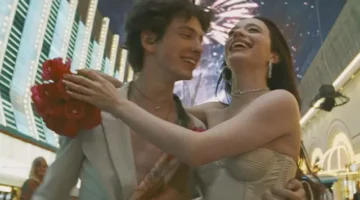Tropic Sprockets
The Lunchbox
The debut film from Ritesh Batra “The Lunchbox” is a retro throwback to the American films of the ‘40s and ‘50s (not to mention Bollywood) in many ways. Yet using such description also limits the film. “The Lunchbox” is stirring, snappy and citric in suspense, certain to keep one guessing at every turn, or in this case with every bite.
Illa (Nimrat Kaur) is an under-appreciated wife. She concocts fragrant and delicious dishes in the hopes of rekindling her husband’s heart. The terra cotta and tense husband Rajiv (Nakul Vaid) is self-absorbed and passive to a fault.
By a chance error, Saajan, a melancholic bureaucrat (Bollywood veteran, Irrfan Khan) receives the lunch intended for Rajiv. The small repast doesn’t have the predictable mush of cauliflower and Saajan is taken aback. Illa is triumphant, thinking that she has scored a goal into her frosty hubby’s heart.
To her surprise, Rajiv merely says the food was fine.
Spurred on by her reclusive yet romantic aunt (only heard as a voice offscreen) Illa creates another salivary seduction.
One that proves spicy.
Saajan responds to the introduction, simply writing that the meal upset his stomach and that he was moved to eat a banana.
A rapid friendship unfolds, driven at first by glib and pithy notes. Wanting to experience fire, Illa puts her mettle into the lusty lunches. In this way, through the tongue and hand, she is appreciated.
Meeting is not an issue. However the two become more and more curious in their short correspondence. Saajan looks forward to the gustatory meetings which are a break from cheerless work and not least, an oasis from the haunt of his deceased wife. The cuisine also extends Saajan horizons, opening up his constrictive Mumbai and making his crushing transit commutes bearable.
These salivary sojourns also make Saajan a more tolerant person. While eating, he is more receptive to the obsequious and needy Shaihk (Nawazuddin Siddiqui). This somewhat taxing and torturing coworker becomes a loyal confidante.
A bubbling satisfaction arises from the subtle and precise performance of Irrfan Khan. He is terrific to watch as we see him melt and change from a stoic cypher—a man who always stands—to a pensive and gentle epicure, lusting for sensation and exile with his victualing vixen that he has yet to meet.
This story pushes and pulls. Mumbai is manic with people, boredom and apprehension.
Lunch remains the colorful respite, in contrast to a routine that stays invariably gray with business and rain.The stainless steel lunch boxes are sealed artillery shells, compartments of possibility or a deck of stacked Tarot cards that point to another life.
Ritesh knows his cinema history. What starts as pure romance, cracks and even curdles, fermenting to an uncertainty and wish-fulfillment, both jittery and heartfelt.
Though the medium of a shared meal, these two pedestrian characters are put into the realm of a joy that has been much celebrated, used up, thrown, and taken for granted.
The zest of “The Lunchbox” is in whether these two will carry their delectable desire all the way or become blocked and thwarted, either by Ganesh or by their personal “hungry ghosts” and remain simply a mere missive to one another.
Under the Skin
Just when you thought it was safe to go on a date, here is “Under the Skin”, a new film by director Jonathan Glazer (Sexy Beast). The film based on a novel by Michel Faber is tense and minimal which makes for some enigmatic viewing to say the least.
An anonymous woman (Scarlett Johansson) falls to earth by some kind of device out of a Kubrick film. This machine or orifice is round, porcelain white and eye-like. It emits some kind of communication and mimics a solar eclipse, but the who, what and where answers are unclear and poetically opaque.
At any rate, we have a femme fatale landing in rural Scotland complete with fishnet stockings and little else.
This is not a creature that likes a wardrobe.
She is taken by a faceless biker to some dim location.
Abruptly, she walks through a shopping mall, watching various women preen, primp, gobble and shop vacuously. This is executed well with some cinematography reminiscent of a George Romero zombie flick.
Then we see the alien woman driving a truck. She asks strangers the way to the post office and then offers them a lift. Most often they take her up on it. This straight talker (although not much for idle chatter) seems taken by jock types but she is acutely short on charm.
She takes one hapless hunk into a dark room of indeterminate spatial dimensions and sets to work undressing, dialogue not included. Despite this woman having a body to envy, it is no sexy affair. The men turn gray and/or sink into a viscous pit of no return. These homicidal hijinks are done in a stark dance of pushing and pulling and walking away in the manner of a panther.
This is no dungeon or inner space that you would want to visit.
In one jolting scene, a man is sucked dry and dedicated while his face remains inflated and puffed like a grotesque balloon. While this is startling echoing something of M.C. Escher, it has little lasting impact.
The alien Johansson emerges into the light and she resumes her endless route to the M8 or the post office.
She goes forth indiscriminately picking out her men, mostly (though not all ) are self centered, clueless and sexist.
In the book, apparently more information is revealed. This woman is an extraterrestrial and these men are used for food sources in factories.
But in the film, explanations are scarce.
The best parts of this story involve Scarlett Johansson’s bemused or passive expressions as one man after another chatters incessantly and nonsensically about his athleticism or domestic dilemmas. As they ramble on, Johansson becomes more and more non-plussed, Although she offers some feigned gesture of interest.
This is where the film earns most of it keep, hovering somewhere between “The Man Who Fell to Earth” and any treatment by David Cronenberg.
By the end of “Under the Skin” we might want a little more mystery —or a little less— but suffice to say that the last image of the film ( with snow covering the camera ) is the most stirring second of all pointing to a Nature that is unconcerned and unmoved, without a care for any paranormal predicament.
Write Ian at [email protected]
[livemarket market_name="KONK Life LiveMarket" limit=3 category=“” show_signup=0 show_more=0]









No Comment